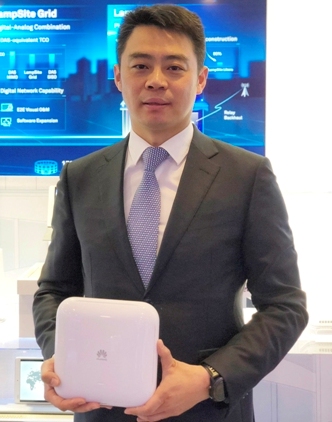At the 2018 Mobile World Congress (MWC), Huawei released a complete 5G wireless infrastructure portfolio covering all 5G frequency bands and including tower, pole-mounted and small cell configurations. The portfolio reflects an integrated, compact and lightweight design, reducing engineering complexity and relaxing the requirements for the antenna installation.
Massive MIMO
For the 3 to 6 GHz 5G bands, Huawei released 64 transmit/64 receive (64T64R) and 32 transmit/32 receive (32T32R) massive MIMO products with 3D beamforming, allowing flexible beams in both the vertical and horizontal planes. This flexibility enables these active antenna units (AAU) to serve various deployment scenarios, with vertical coverage for high-rise buildings and horizontal coverage for wide areas.
The 64T64R AAUs feature broader bandwidth and lower power and can meet network requirements for hotspots and wide-coverage areas.
According to Huawei, the 32T32R AAUs are the lightest in the industry, enabling a single engineer to complete an installation without any mechanical equipment.
Huawei’s C-band 3D-MIMO AAUs were used to establish the first large-scale 5G continuous network in Seoul, South Korea. The network delivers ubiquitous Gbps data rates for outdoor users and several-hundred-Mbps rates for indoor users.
mmWave AAUs
Huawei’s millimeter wave AAUs have 1 GHz bandwidth, with the highest equivalent isotropically radiated power (EIRP) in the industry, according to the company. Multi-Gbps data rates can be maintained within a 1 km radius when line-of-sight propagation is not blocked.
Combining C-Band and millimeter wave AAUs, a field test in Seoul achieved a peak data rate of 20 Gbps.
The optical interface speed of Huawei's AAUs is less than 25 Gbps, which makes the equipment well-suited for large-scale 5G deployment.
5G EasyBlink
In addition to tower-mounted products, Huawei introduced “5G EasyBlink,” which can be deployed on multiple surfaces, including street lamp poles and walls. The volume and weight of the C-Band EasyBlink makes it well-suited for mounting on poles to fill coverage holes and boost hotspot capacity. The weight of the millimeter wave version of EasyBlink is suitable for mounting on street lamp poles, allowing direct and reflected paths to increase data capacity.
Indoor Solutions
The majority of data traffic is generated indoors. However, solutions such as traditional indoor distributed antenna systems (DAS) are not suited to provide 5G indoor coverage; DAS doesn’t support new bands, such as 3.5 GHz, or the use of multi-antenna technologies.
 To provide added indoor capacity and coverage, indoor digitalization is emerging as an essential trend in 5G networking. To meet this need, Huawei introduced what the company says is the first digital 5G LampSite for indoor scenarios. It is backwards-compatible with LTE, supports 4T4R multi-antenna mode and boasts integration in four areas:
To provide added indoor capacity and coverage, indoor digitalization is emerging as an essential trend in 5G networking. To meet this need, Huawei introduced what the company says is the first digital 5G LampSite for indoor scenarios. It is backwards-compatible with LTE, supports 4T4R multi-antenna mode and boasts integration in four areas:
- all sub-6 GHz bands,
- CAT6A and fiber,
- 4G and 5G,
- enhanced broadband services and future IoT services.
Existing 4G indoor small cell CAT6A network cables or fiber optic cables can be reused in a 5G LampSite deployment, with no additional cable adjustment or site addition. Engineering is simplified and construction cost substantially reduced. Telecom and tower operators can deploy 5G indoor digital networks with the lowest possible total cost of ownership.
C-RAN and D-RAN
Huawei also announced 5G centralized radio access network (C-RAN) and distributed radio access network (D-RAN) solutions. Part of its C-RAN solution, the CBU5900 centralizes the deployment of a large number of baseband units, enabling quick satellite clock synchronization across the network, simplifying remote sites and reducing the demands for air-conditioned equipment rooms.
Huawei says the D-RAN BBU5900 is the most highly integrated site solution in the industry, supporting all radio access technologies (2G, 3G, 4G, and 5G) and frequency bands. It offers multi-Gbps backhaul capability to meet 5G data rates.
Both the C-RAN and D-RAN solutions feature an all-cloud architecture that supports the split and flexible deployment of centralized units and distributed units.
